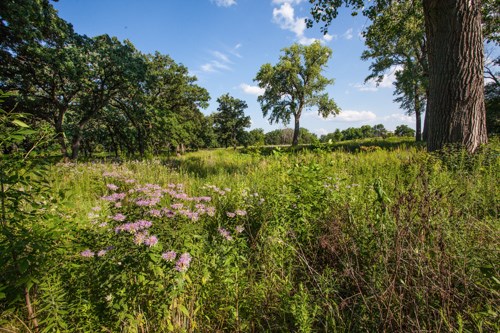
NPS photo IntroductionAn oak savanna is a community of scattered oak trees (Quercus spp.) above a layer of prairie grasses and forbs. The trees are spaced enough so that there is little to no closed canopy and the grasses and forbs receive plentiful amounts of sunlight. The savanna is often thought of as a transition system between the tallgrass prairie and woodland environments, but may contain species that are found only in it and not in either forest or prairie. As a result, it is an important and diverse system containing species from both woodland and prairie, but containing some species that is unique to only savanna. Once common in Minnesota, the oak savanna is now a rare ecosystem. Before European settlement, oak savanna covered roughly 10% of the state, and now there is only a fraction of that left. What happened? Savannas rely on periodic disturbances such as fire, grazing, and drought to flourish. Such disturbances prevent most tree species from establishing themselves and turning the habitat into a forest community. Fire-adapted trees, such as bur oak trees with their thick, corky bark, and prairie grasses are resilient to fire and do well in environments where fire is a common occurence. Without fire, tree saplings begin to grow in the savanna and are able to take over, shading out and eliminating the grass and forb species. Soon, where there used to be an oak savanna, there is now a woodland habitat. Oak savannas have become rare because settlers suppressed fires. Farming and development has also helped obliterate the oak savanna ecosystem. Oak savannas are important because they are beautiful, dynamic environments with diverse plants and animals that have evolved complex relationships over time. Since savannas are transitions from prairie to woodland, they have extremely high diversity in flora and fauna. Diversity is a measure of health and stability, so it is important that habitats with diverse native plants and animals exist. Visit an Oak SavannaCedar Creek Natural History AreaLocated 40 minutes north of the Twin Cities, due west of the town of Stacy. Contact the University of Minnesota ecology program for more information at (612) 625-5700. Fort Snelling State ParkLocated in St. Paul, MN. Contact the MDNR Information Center for more information at Coldwater SpringLocated near Minnehaha Regional Park, this restoration of a historic location takes a visitor back to what the area probably looked like in the early 1800s when U.S. soldiers camped here while construction the nearby Historic Fort Snelling. Oak Savanna RestorationLocated on East 36th Street and West River Parkway in Minneapolis. Contact the Minneapolis Park and Recreation Board (612)370-4900, or the Mississippi National River and Recreation Area (651)290-3030 for more information. The Friends of the Mississippi River sponsors stewardship events throughout the Mississippi River Gorge, including projects at this oak savanna restoration. Restoration Projects |
Last updated: October 7, 2024
